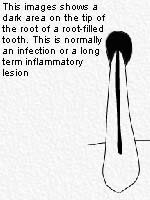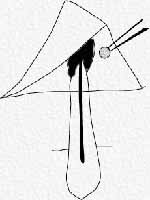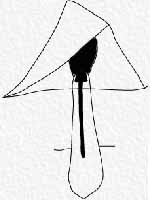What Is An Apisectomy?
The term apisectomy refers to the surgical procedure where the apex, or root tip, is cut off and the root canal ( the tunnel that the nerve resides) filled from the top (or bottom) down (up). Apisectomies are indicated when:
- there is an infection at the root tip that fails to resolve (heal).
- a part of an instrument lodges at the tip of the canal during root canal treatment.
- a cyst attached to the tip of the root - a radicular cyst.
How Is It Done?
An apisectomy is day surgery and depending on the tooth can take from 45 minutes to an hour a half. Your dentist will numb the area and the tooth before surgery. Occasionally, you may require sedation either orally or intravenously.

The Problem
The image on the left shows a tooth with a root filling, there is an abscess or a space in bone around the tip of the root. This may be a infection that started AFTER the root canal was carried out or it may be an abscess space that has failed to heal and be replaced with bone. This potential space may remain quite comfortably in bone without any problems but occasionally it may become infected or turn cystic (a cyst is a fluid filled space in bone that is not infectious in origin). This may cause discomfort and need treatment.
Surgical Exposure
An incision is made along the gum line and the gum covering the overlying bone is lifted or peeled off. This exposes the area we wish to work in, the space in bone at the root tip may be visible but it is sometimes covered by a thin layer of bone. Your dentist will then use a drill to expose the defect. He may use a scoop-like instrument called a currette to remove any abscessed tissue from the space at the root tip. This cleans the area a prepares it for good healing.
Filling
The tip of the root is then cut off, leaving a truncated root. The tip of this is then filled with amalgam to further seal the bony region from the root canal. The gum flap is then sutured back in place.Post Op Care
The area will feel a little tender for a few days and you will have to work at keeping your mouth clean. A clean mouth is less likely to suffer from infection, and it is essential that the operative site remains infection free. Your dentist may prescribe painkillers to subdue or dampen the pain. The sutures will be removed in about 5 days, sometimes your dentist may choose to use resorbable sutures - these fall out in a few days, removing the necessity to go back. Most dentists will use non-resorbable sutures as they can then check the site to make sure that healing is progressing well when they see you for the suture removal.You will have to return for a reassessment appointment in a few weeks time, an x-ray will be taken here to make sure that the bone is starting to regrow at the root tip. You may also have to return for a 6 monthly and yearly recall visit to make sure everything is alright.